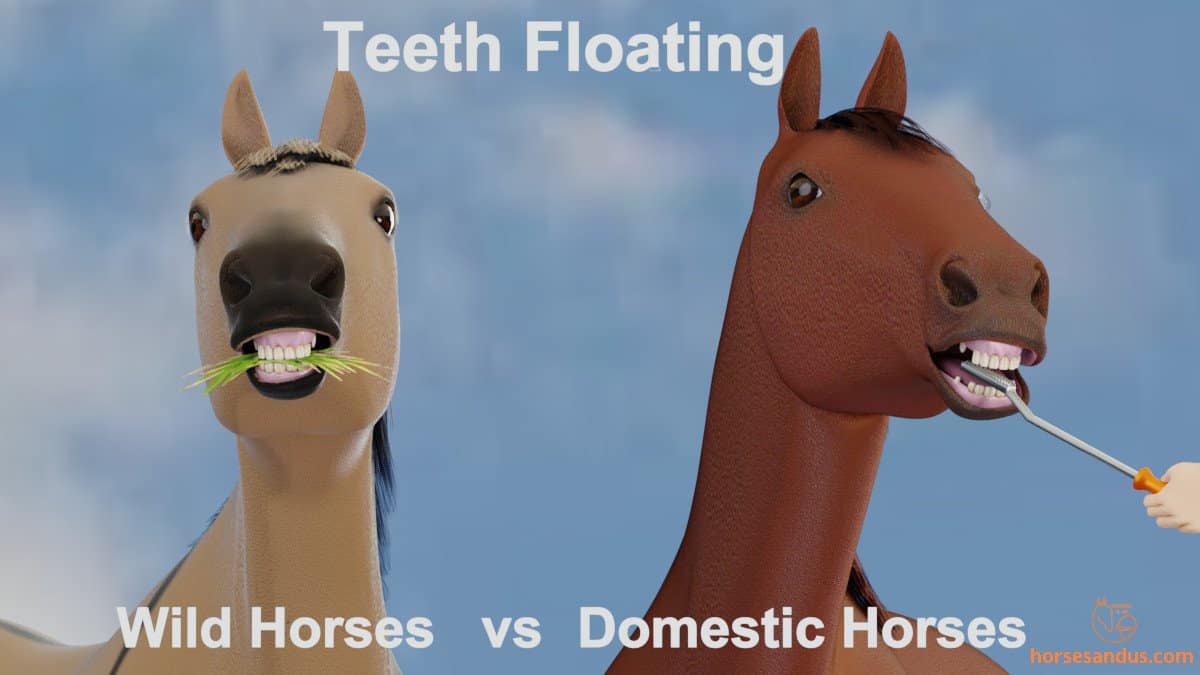Common horse teeth problems include: abnormal teeth wear (such as points and hooks), dental diseases (caries and periodontal disease), retained caps, teething bumps, displacements, diastema, fractured and missing teeth, and congenital disorders.
The horse’s teeth anatomy and function has evolved over millions of years to cope with the feed necessary for their survival. Their hypsodont teeth with lifelong eruption to compensate for the wear have been finely tuned. The chewing mechanism is designed for grinding coarse feed and serves the horse very well.
However the domestication of horses has led to:
So the way domesticated horses are managed has resulted in the appearance of dental disorders and diseases of the mouth’s soft tissues, which are much less frequent in wild horses. You may want to check this article to learn how wild horses maintain their teeth.
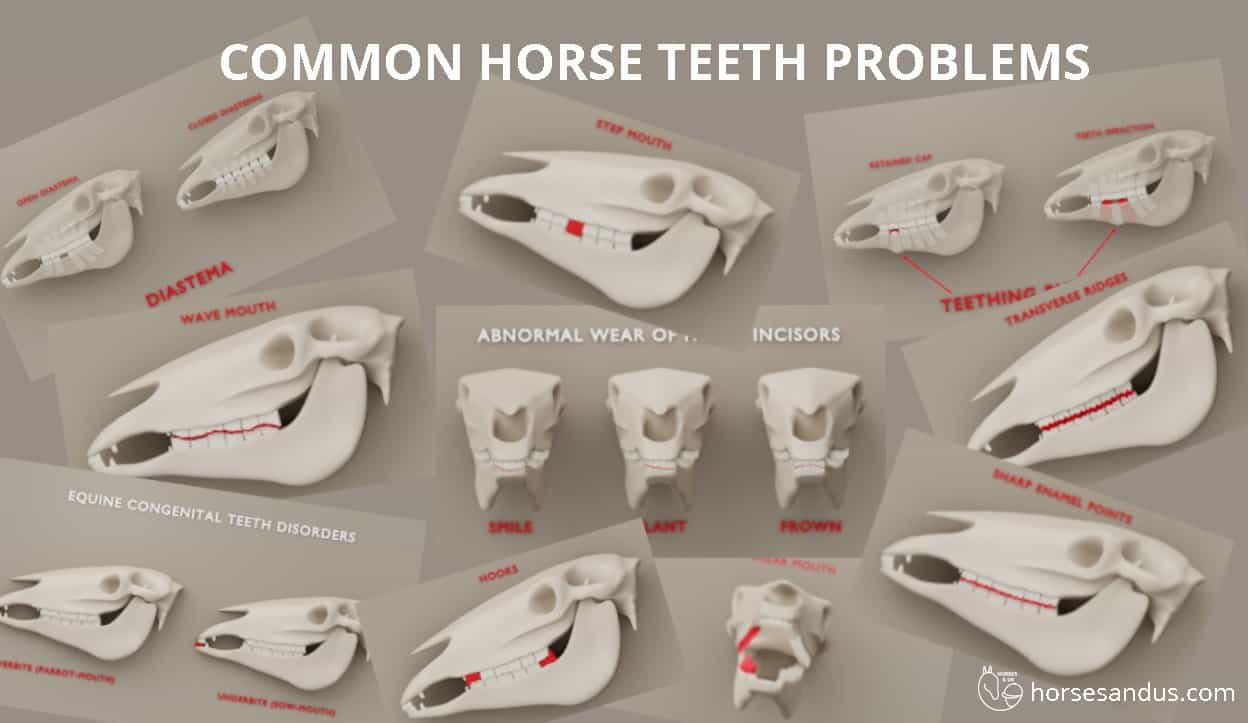
1 – Abnormal Teeth Wear Patterns In Horses
The abnormal wear of teeth is the most common dental disorder in the domesticated horse.
Anything that disrupts the normal occlusal contact of upper and lower teeth will result in irregular wear.
Abnormal Wear Of Horse Incisors
Abnormal wear of incisors can be caused by anything that inhibits the incisors’ proper use, which is cutting and pulling grass.
The most common abnormal patterns of incisors are smile, frown, and slant. These anomalies can also impact the cheek teeth’ normal contact, affecting the horse’s capacity to grind its food correctly.
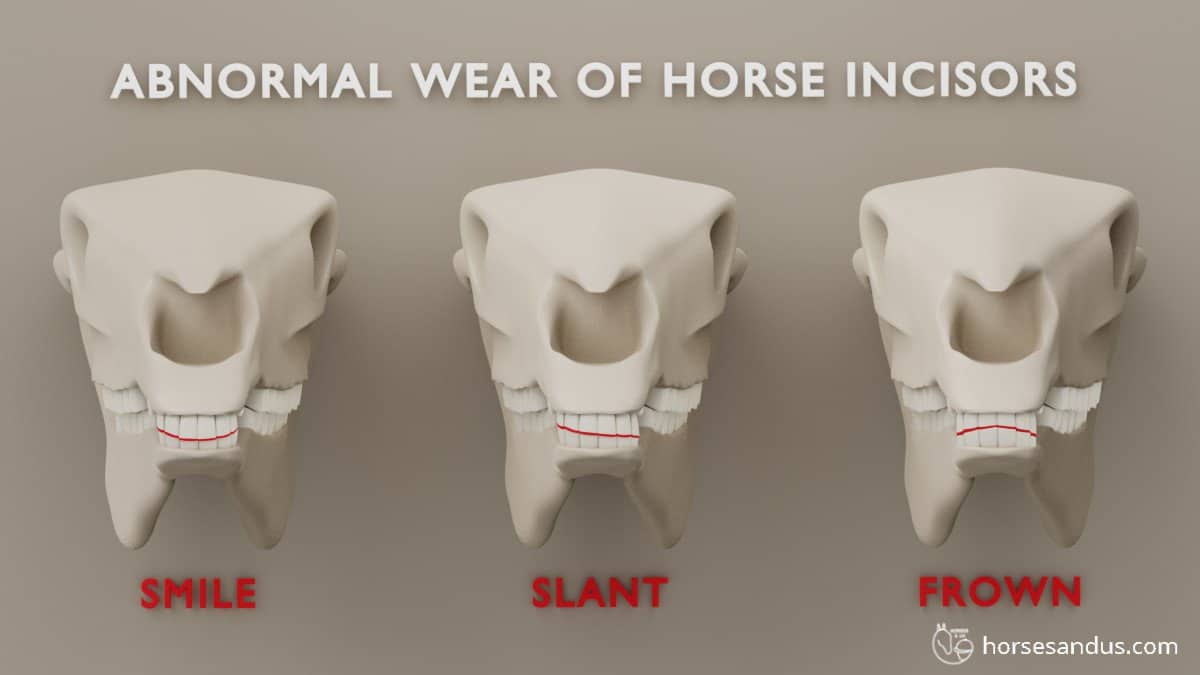
Incisor Smile
The Smile pattern is when the incisors are curved upwards, resembling a smile.
This happens when the upper central incisors and the lower corner incisors overgrow.
Causes
This irregular wear is often caused by a parrot-mouth abnormality.
Consequential problems
The smile abnormal wear restricts the jaw sideways movement, resulting in abnormal wear also in the cheek teeth.
Solution
This abnormal wear, when mild, can be corrected by floating. However, floating on incisors should always be done with care. Also, the originating cause should be treated.
Incisor Frown
The Frown pattern is when the incisors are curved downwards, resembling a frown. It is the opposite of the smile, where the lower central incisors and upper corner incisors overgrow.
Causes
This irregular wear is often caused by a sow-mouth abnormality
Consequential problems
It causes similar problems in the cheek teeth as the smile does.
Solution
This abnormal wear will require a similar treatment as the smile.
Incisor Slant
Incisor slant is when the incisors are slanted.
This happens when upper incisors on one side of the mouth and lower incisors on the other side have overgrown.
Causes
This problem can be caused due to the asymmetry of upper and lower jaws, or shear mouth.
Consequential problems
The slanted mouth will also cause abnormal wear in the cheek teeth.
Solution
This abnormal wear can be corrected by floating, but leveling of the incisors needs to be carefully evaluated and the originating cause taken into account
Abnormal Wear Of Horse Cheek Teeth
The cheek teeth, molars, and premolars are the ones that have the most issues with abnormal wear.

We will now look into each of the most common abnormal cheek teeth wear patterns:
Sharp Enamel Points
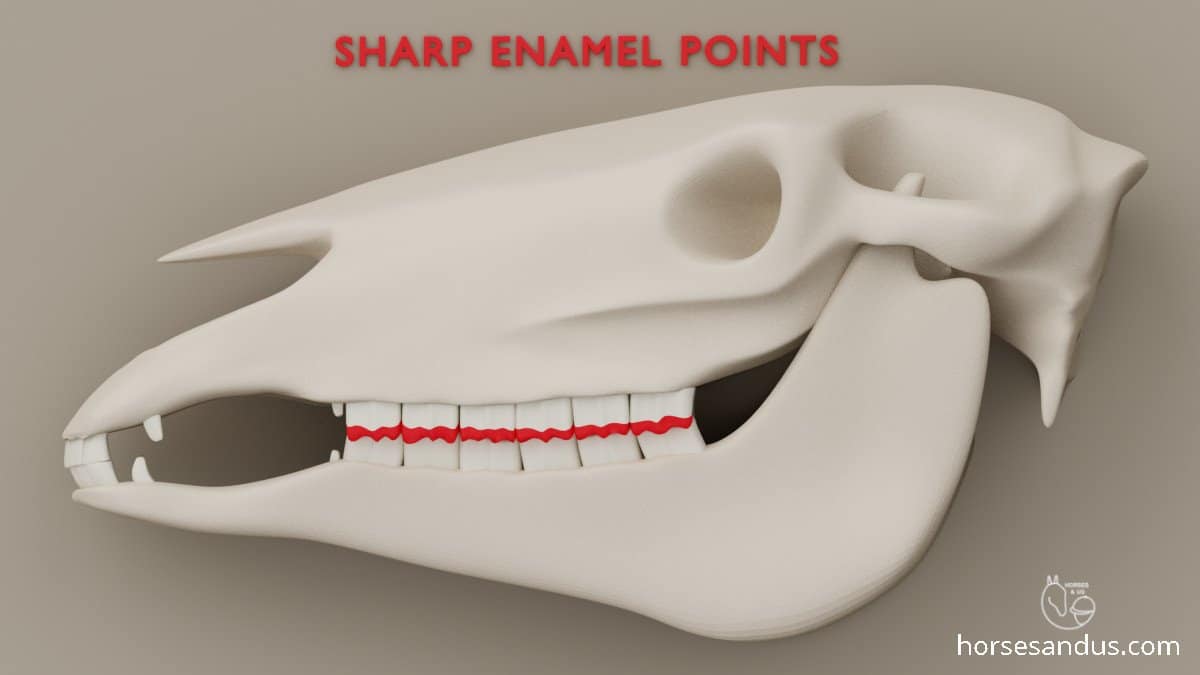
Sharp enamel points is the most common dental problem found in horses.
Sharp enamel points are teeth overgrowths on the outside edge of the upper cheek teeth and the inside edge of the lower cheek teeth.
When the sideways chewing movement is not done completely, these edges will not come into contact with the opposing teeth, and so sharp overgrowths will occur.
Enamel points develop at these locations because the maxillary cheek teeth rows are wider apart than the mandibular cheek teeth rows (Anisognathia).
Causes
Enamel points are mainly caused because the horse is eating a processed food diet that does not require a complete sideways chewing motion. This results in irregular overgrowth of the parts of the teeth that are not involved in the grinding of food and therefore do not wear down normally.
Consequential problems
These sharp enamel points can injure the soft tissues (cheeks and tongue), causing painful ulcers. This will cause discomfort and pain when chewing.
Chewing is painful, and the normal sideways motion is not possible, causing abnormal wear on other teeth.
Solution
Float the horse´s teeth to remove the sharp enamel points. Also, introduce fibrous feed in the horse’s diet, such as hay and grass, to enforce the complete sideways chewing motion, to prevent the return of enamel points.
Hooks

Hooks are dental overgrowths on the front edge of the first cheek teeth (rostral hooks) and the back edge of the last cheek teeth (caudal hooks).
Whenever there is a misalignment of the jaws (overbite or underbite), the edges of the first and last cheek teeth will not contact the opposing teeth, so they will become longer and develop hooks.
Causes
Hooks can be caused by:
Consequential problems
Solution
Usually, the hooks will need to be floated. The underlying causes (diet, overbites, underbites, or other malocclusion problems) should also be fixed whenever possible to prevent the reappearance of hooks.
Ramps

Horse’s teeth ramps are dental overgrowths on first cheek teeth and the last cheek teeth. They are similar to hooks, but ramps are a gradual slope on the whole tooth, while hooks are just on the tooth’s edges.
Causes
Ramps are most common in the lower first cheek teeth and are usually caused by a delay in the eruption of the opposing upper tooth due to retained cap (deciduous tooth)
Consequential problems
Solution
Usually the ramp will need to be floated until the opposing tooth grows over time.
Step Mouth
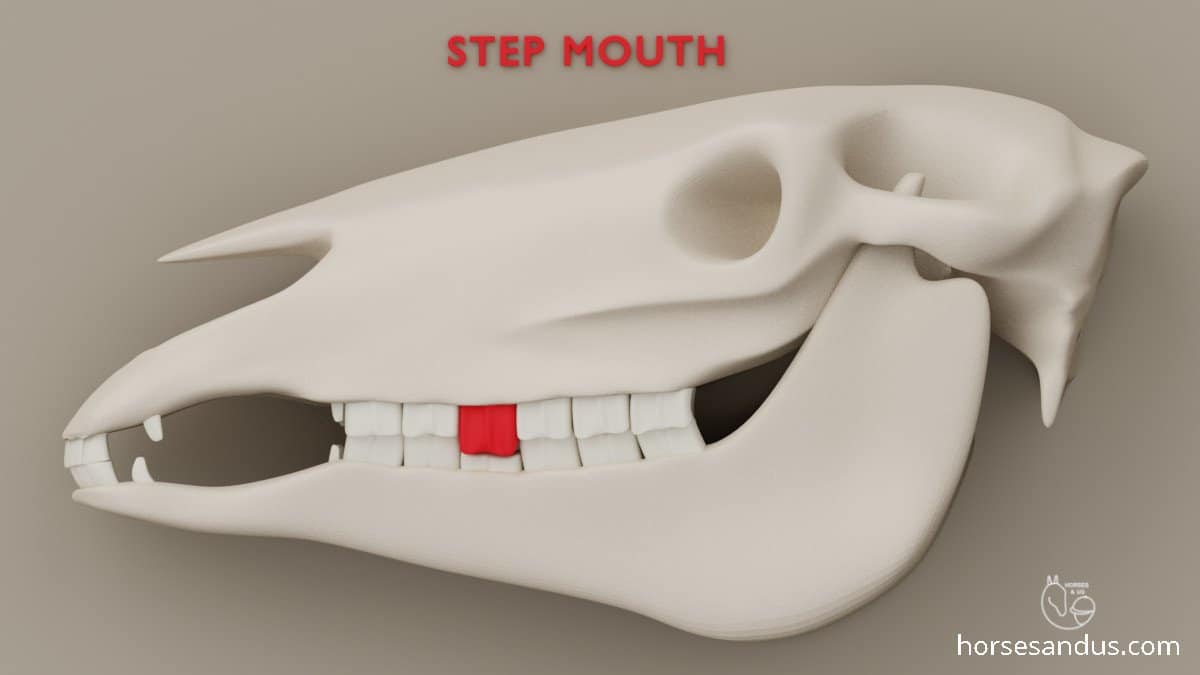
Step mouth is when one tooth is longer than the others on the same row. This happens if one tooth does not have an opposing tooth (missing, fractured, or shorter) to wear it down, and so it will grow into the void.
Causes
Step mouth usually occurs when an opposing teeth is shorter or missing due to:
- Impacted tooth
- Retained caps
- Broken tooth
- Missing tooth.
Consequential problems
Solution
Reduce the size of the high (step) cheek tooth to allow free chewing movement. This tooth will require maintenance until the opposing tooth problem is resolved.
Wave Mouth

Wave mouth is an abnormal teeth wear that creates a wavy line between upper and lower cheek rows. It results from several overgrowths caused by missing or shorter opposing teeth.
Causes
Wave mouth usually occurs in older horses and derives from dental problems that occurred and were not fixed when the horse was younger, such as:
Consequential problems
Solution
Cutting or rasping the overgrown teeth to recover growth in opposing teeth. However, this condition can be difficult to fully correct and will require periodic maintenance.
Excessive Transverse Ridges

Excessive transverse ridges are an overgrowth of the natural ridges running across the cheek teeth’ chewing surface.
These ridges become exaggerated when the harder parts of some teeth dig into and wear down the opposing teeth’ softer parts. This happens whenever teeth substances of equal hardness are not aligned between opposing teeth.
These natural ridges are necessary to grind coarse feed, but when they are excessive they inhibit the correct chewing process.
Causes
Excessive transverse ridges can be cause by:
Consequential problems
Solution
Reduce (float) the accentuated ridges to allow opposing teeth to recover from excessive wear. This may require two or three sessions to fully correct.
Shear Mouth

A shear mouth is a condition where the cheek teeth’ natural slope becomes extremely acute, resulting in sharp edges. It can occur on one side or both sides of the mouth.
Unilateral shear mouth happens when the horse has limited sideways movement and chews only on one side of the mouth, which will cause overgrowth on the other side, which starts with enamel points and then progress to shear mouth.
Bilateral shear mouth can occur when the width disparity (anisognathia) between the upper and lower jaw is greater than normal.
At some point, the sideways chewing movement becomes impossible. So the horse will instead use the front to back movement to grind its food, which causes the shear angle to become even more aggravated. The angle of the sheared teeth can go up to 50-60 degrees.
Causes
This condition is not yet clearly understood but some studies suggest the following causes:
Source of this information: Clinical findings and treatment of shear mouth.
Consequential problems
Solution
Correction of the occlusal surface both on the affected cheek teeth and the incisors that were also affected. This correction will require several interventions over time.
2 – Equine Dental Diseases
Teeth can develop diseases due to trauma, diet or abnormal wear over time. The two most common dental diseases in horses are caries and periodontal disease.
Equine Caries
Dental Caries are quite common in horses and consist in the destruction of the teeth structure.
There are two types of caries in horses:
Causes
Caries are mainly caused by:
The acidic environment will erode the tooth’s surface, which allows bacteria to get in and further decay the tooth.
The outside layer of the tooth is covered with cementum, and also the infundibulum is filled with cementum. Cementum is very prone to develop caries because its critical PH (PH level at which it starts to decompose) is 6.5. So it does not take a very acidic environment to start decomposing it.
Consequential problems
Solution
The best solution is prevention by having regular dental checks, just like we do. This will allow to detect caries in the early stages, which can be fixed by putting a fill in the tooth.
In more advanced cases where caries have led to secondary problems such as fractures, pulp infections, and periodontal disease. These will need to be treated.
This is a very interesting video that explains caries in detail.
Equine Periodontal Disease
Periodontal disease is the inflammation of the periodontium (structures that surround and support the teeth):
- Gingiva (Gum)
- Periodontal ligaments (anchor the tooth to the socket)
- Cementum
- Alveolar bone (bone in which the tooth sits)

The disease starts when bacteria multiply around the tooth leading to inflammation of the gum. This causes a gum recession, which leads to the tight seal around the tooth being lost, allowing food to be trapped in the gap (periodontal pocket). The process perpetuates as the inflammation extends deeper into the periodontal ligament. It may even extend to the alveolar bone.
Periodontal disease is very painful and is common in horses especially in older horses. It is the main cause of tooth loss.
Causes
Two most common causes of periodontal disease are:
Which are caused by other dental conditions such as displaced teeth, missing teeth, diastema and caries.
Consequential problems
Due to the periodontal pocket opening, the tooth is no longer secure, which can lead to its displacement. As the disease progresses down the tooth, it can eventually lead to tooth loss.
When the disease has progressed down the tooth, an apical abscess can develop. When this happens in the upper cheek teeth, it can lead to infection of the sinuses.
When the gums bleed, the bacteria can enter the horse’s bloodstream and travel to other parts of the body, causing additional infections.
Solution
The first step is to clean the trapped food from the tooth and control the bacteria to prevent further disease progression and destruction of the periodontium. This may require several interventions until the infection is resolved.
The gaps that allow entrapment of food should be treated:
Dental overgrowths and malocclusions can be an important contributor to periodontal disease. In these cases, their correction should be part of the treatment.
If the disease has progressed too far, then the tooth may need to be extracted.
3 – Retained Caps In Horses
Retained caps are the deciduous teeth that do not fall off to let the permanent teeth push through. This condition is common in young horses between 2,5 and 4,5 years of age when the deciduous teeth transition to permanent teeth.
Retained caps can occur in incisors and premolars. They can easily be seen in the incisors, but only a veterinary can detect them in the premolars.
As the foal grows older, the deciduous teeth wear away into a thin shell, which is called a “cap.” As the permanent teeth erupt through the gums, they loosen these caps, which sit on top of them and, after some time, will fall off naturally during grazing.
However, sometimes this does not happen as smoothly as it should, and the deciduous cap remains in place, which is a condition known as a retained cap.
Two situations can occur with these caps:
Consequential problems
When these caps are retained, the permanent teeth cannot push through resulting in two possible conditions:
Retained caps are painful for the horse and can result in inflammation and infection.
When these caps are broken and become lodged between teeth, this may result in soft tissue injuries.
Solution
Usually in these cases the problematic caps are removed by a qualified veterinarian.
4 – Teething Bumps In Horses
Like retained caps, teething bumps are also quite common in young horses between 2,5 and 4,5 years of age when permanent teeth erupt.
Teething bumps (eruption cysts) are bony protrusions that may develop in the upper jaw or lower jaw when the permanent teeth are trying to push through the gum but cannot erupt due to some obstacle such as a retained cap or overcrowded arcade. They can be easily seen in the lower jaw, but they are less obvious in the upper jaw because they are hidden within the nasal passages.

Causes
These bumps are caused by the pressure of the permanent tooth growing in the apical direction because the tooth cannot push through the gum due to:
Consequential problems
Sometimes these bumps grow larger and become tender and hot, which means an apical infection has occurred.
Solution
Usually, the problem will correct itself as the permanent teeth gradually force their way up (when the retained cap has fallen or the jaw grows longer, leaving room for the new tooth). The bumps will eventually disappear.
However if an infection has set in it should be treated by the veterinary.
When possible the causing problem should also be fixed such as removing the retained cap.
5 – Displacements In Horse’s Teeth
A tooth displacement happens when the tooth is blocked from erupting in the correct position and instead erupts in a displaced position. This article has information about the teeth eruption schedules.
Causes
Consequential problems
Solution
If the cause of displacement is the retained deciduous tooth, then its removal should be considered.
If the displacement is causing severe problems that cannot be corrected, then the displaced tooth’s extraction may be necessary. This is usually only performed in older horses.
6 – Teeth Diastema In Horses

A teeth diastema occurs when there is a gap between two teeth.
Diastema is usually limited to cheek teeth, but can occasionally affect the incisors.
Causes
Open diastemas usually occur in cases of displaced or missing teeth. Also, when the cheek teeth are not compressed due to insufficient angulation on the arcade’s first and last teeth.
Each row’s cheek teeth need to be tightly compressed to form a single unit for optimal chewing. To allow this, the first and last teeth need to be inclined towards the middle ones.

A closed diastema is more common in older horses due to tooth wear and eruption over time. It is due to the shape of the tooth, which narrows down as it comes closer to the root, so as it erupts later in life, it is wider on the surface than near the gumline, which creates space between the teeth.
Consequential problems
Food gets easily trapped in these gaps, especially in the case of closed diastema. The food will then quickly decay and create gum infection (periodontal disease). This can be very painful for the horse and lead to quidding and foul-smelling mouth.
Solution
The first action is to remove the trapped food.
Next there are several options which include:
7 – Fractured Teeth In Horses
Horse teeth fractures are very rare (less than 1% of dental problems)
Causes
The fractures can be caused by traumatic events such as falls, kicks in the mouth, or accidents from dental treatments.
But most commonly, they have no obvious evidence of trauma. The tooth has been weakened and eventually fractured due to an underlying problem such as infundibular caries, root infection, or abnormal wear patterns.
Consequential problems
Small fractures that do not go beyond the gumline may not cause any problems. However, the fractured tooth’s sharp edges may cause injuries to the surrounding soft tissues (gums, tongue).
The opposing tooth may overgrow into the void left by the fractured tooth (step mouth).
Bigger fractures may involve deeper structures of the tooth (pulp cavities) and lead to bacterial infection of the tooth.
Solution
The treatment will depend on the severity of the fracture and the underlying disease.
The fractures can be treated by removing the small pieces or floating the sharp edges. The length of the opposing tooth may also need to be shortened.
Sometimes it is necessary to remove the tooth.
8 – Missing Teeth In Horses
Missing teeth can occur due to extractions, periodontal disease, complete wear away, or genetics. This can severely impact a horse’s ability to chew food properly, which in turn can lead to digestive difficulty.
This condition is more common in older horses but can also occur in younger horses for different reasons.
Causes
The main causes of missing teeth are:
- Periodontal disease.
- Complete wear away due to age.
- Extractions
- Genetics
Consequential problems
A missing tooth can lead to:
- Such as step or wave mouth due to the overgrowth of the opposing tooth.
- Adjacent teeth usually move into the space left by the missing tooth, causing a misalignment of the upper and lower arcades.
- The pressure made by the opposing overgrown tooth.
- The empty tooth socket will trap food, which decays and causes infection.
Solution
This condition cannot be treated but it needs to be managed.
Adapt the horse’s diet, so the horse is not so dependent on the chewing process to digest the food.
Regular dental appointments to detect and treat any secondary problems caused by missing teeth:
9 – Congenital Teeth Disorders in Horses
Congenital anomalies are present at birth and are considered a deviation from the normal anatomic growth. They may have developed in utero or may have genetic origins.
Parrot-Mouth (Overbite) and Sow-Mouth (Underbite)

Parrot-mouth (overbite) is when the upper incisors protrude further forward than the lower incisors. Many horses have some degree of Parrot-Mouth, but most times, it is just a slight misalignment, where the upper and lower incisor still meet and does not cause any problems. However, in severe cases, the incisors do not meet at all.
Sow-mouth (underbite) is the opposite of Parrot-mouth, i.e.; the upper incisors are more recessed backward than the lower incisors. Sow mouth is a very rare abnormality.
Causes
Congenital
Consequential problems
The main problem from parrot-mouth and sow-mouth is abnormal teeth wear:
- Parrot-mouth – hooks/ramps on second upper premolars and third lower molars
- Sow-mouth – hooks/ramps on second lower premolars and third upper molars
Solution
Floating the overgrown teeth.
Orthodontic correction in severe cases, but is only effective when the horse is still young.
Supernumerary Teeth
The occurrence of supernumerary (additional) teeth is relatively uncommon in horses.
Causes
Supernumerary teeth form when a “tooth germ” splits in half, causing excess teeth to be formed in the young horse´s mouth.
Consequential problems
Solution
When possible the extra teeth should be extracted to allow the other teeth to erupt and align correctly.
Secondary problems, such as overgrowth, a diastema, and periodontal disease should be treated.
